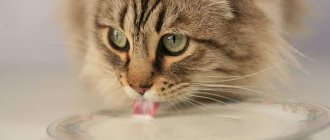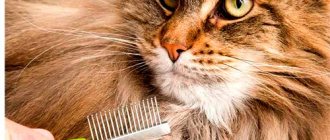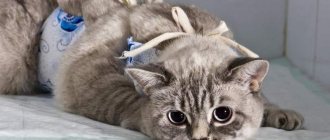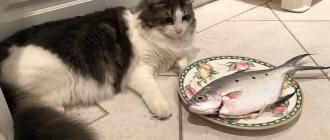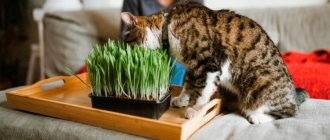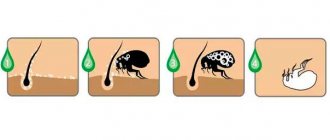Inexperienced owners of four-legged pets often wonder whether cats can be given milk. In this case, experts are unanimous that feeding cats with milk is prohibited, since they do not produce lactose to digest milk sugar.
But this is not typical for all cats. It's like a person is allergic to strawberries, some have it, some don't. Likewise among representatives of the cat world, some cats will drink milk every day and enjoy it, while another, after such joy, may not have time to run to the toilet, since the milk will cause her an attack of diarrhea.
Milk in a cat's diet
The cat feeds its kittens from birth to three months, while lactose is produced in the kittens' bodies. Enzyme for processing milk sugar. Gradually, the kitten begins to switch to adult food, replacing the mother's milk with solid food, meat or dry food.
Accordingly, the production of lactose is reduced, and this enzyme is replaced by protease, an enzyme for processing proteins. In this case, the cat gets what it wants and the owners are happy that they were able to pamper their pet. After all, milk is a treat for cats, and you can feed your cat milk every day.
The benefits and harms of dairy products for cats still have no clear assessment among veterinarians and felinologists, because representatives of the animal world in the wild do not consume it, so whether cats can have milk is an ambiguous question.
Of course, it contains a lot of calcium and nutrients, but it is very fatty, especially cow's milk. However, there is an opinion that it is the fatty acids that attract tailed fluffies in this drink. Thanks to fatty acids, cat treats acquire such a pleasant taste.
The dairy product contains lecithin, cholesterol, vitamin A and D, which take part in many hormonal processes, the formation of skin and hair.
However, it is impossible to give milk in its entirety, no matter what it is. After all, we do not have a complete list of necessary microelements for the life of pets. Moreover, if a cat eats only a milk drink, it can die.
Is it possible to prepare milk formula for kittens at home?
Factory-made cat milk replacers are quite expensive. In addition, it is not always possible to purchase them quickly, but feeding kittens must begin literally immediately after their birth.
Although veterinarians do not recommend feeding kittens with homemade milk formula, we will still look at the most common recipes. They are suitable as an emergency and short-term replacement for breast milk. So here they are :
- You need to take 500 ml of milk, mix with one chicken yolk and four tablespoons of sugar. To the resulting mixture you need to add vitamin preparations crushed into powder (Revit, Vetoron or analogues).
- You can feed kittens with baby formula, diluting it with water as indicated on the package. Nutrilon is best suited for this.
- Take condensed milk (20%) without sugar and water. You need to add bone meal to it (1 tablespoon per 1 liter of liquid). The mixture prepared according to this recipe is suitable for newborn babies.
© shutterstock
The resulting mixture should be well mixed. You need to feed the kitten through a pipette or syringe as carefully as possible so that the baby does not choke. Before feeding, the mixture must be heated to 39-40 degrees. It is not recommended to store this mixture for a long time. It is better to immediately cook exactly as much as the kittens can eat at a time.
Milk for adult cats
Dairy products for cats, just like milk for cats, are a great treat. Milk can be given to cats if individual tolerance is good and there are no allergic manifestations. But it should be noted that castrated cats are prone to obesity, and cow product contains 149 kcal.
Therefore, drinking plenty of this drink together with dry food or food from the table can lead to an increase in the weight of the animal, which will negatively affect the cat’s body as a whole.
Therefore, you need to feed your cat dairy products in moderate doses. For a cat, as a more active creature than a lazy cat, these calories are not so significant, so cats can drink milk in any volume.
Tastes and habits
Cats, like people, are different from each other and have their own preferences. Even animals living in the same house do not always have the same attitude towards things, objects, games and food.
Most pets enjoy eating meat and fish. And personal preferences are formed towards milk. If we compare country and city cats, then mustachioed rural residents are more spoiled by dairy products. The freshest and richest sour cream, cream and cottage cheese are available to them.
Among cats there are gourmets who do not drink fresh product. They prefer to lick the resulting cream from the surface or wait for the milk to turn into curdled milk, and then eat it.
Milk for kittens
Sometimes a cat cannot feed her babies due to a disease of the mammary glands, the kitten does not drink water. In this case, it is necessary to decide what to feed newborn kittens, at what age, and whether it is possible to replace cat milk, as well as in what doses to give milk to the kitten. In this matter, each owner is free to act at his own discretion: feed the kittens with cow food or feed them with goat food.
The disadvantages of cow's milk for cat babies is that it is less nutritious than mother's milk. Cow's milk may contain antibiotics or estrogens - female hormones that are present in the cow if she was pregnant at the time of milking.
Goat milk is, of course, preferable for kittens. It is given because it contains more nutrients, vitamins, and is better absorbed by cats' tummies. Goat milk for cat babies is hypoallergenic, but experts still recommend diluting it with water in a 2:1 ratio.
Kittens drink goat product with great pleasure. Therefore, if you choose between cow's and goat's milk, then goat's milk is better, although kittens can be given both cow's and goat's milk.
Can a fold-eared kitten have milk?
Owners of purebred kittens have a different opinion, such as Scottish Fold, for example. They take the feeding of their future winners more responsibly, so they do not give newborn kittens milk from goats and cows, but feed them with formula milk.
Of course, lop-eared kittens can be given dairy products, but owners are afraid that cow's drink is not very nutritious and beneficial for the lop-eared kitten, for the noble skin of an expensive animal and for the health of the cat, so they prefer an adapted milk formula.
Why raw milk can be dangerous
Milk is a favorable nutrient medium for the proliferation of harmful microorganisms.
Pathogenic microbes that may be in milk:
- Bacillus cereus is a conditionally pathogenic bacteria that produces toxins. With strong reproduction it causes poisoning. Spores are killed only by boiling.
- Campylobacter affects the digestive tract, causes diarrhea, and dies at 60 °C.
- Pathogenic strains of E. coli cause eating disorders with diarrhea and vomiting.
- Pathogenic forms of staphylococci provoke vomiting and diarrhea.
- Listeria affects nerve cells; in severe cases, encephalitis and meningitis develop after infection.
- The bacterium survives at temperatures of 4–50 °C and is stored in refrigerators.
- Coxiella Burnet does not cause acute symptoms in cats, but is transmitted to humans through it.
Pathogens enter milk from the body of infected cows or from the environment when the product is improperly stored.
Fermented milk products in the diet of cats
If adult cats do not digest milk, what can you do to pamper the cats? Surprisingly, fermented milk products are absorbed by cats much better than dairy products.
Sour milk contains enzymes that help the gastrointestinal tract function properly. Therefore, you can try giving your pet kefir, fermented baked milk, and cottage cheese. Fermented milk products can harm an adult cat in less quantities than kittens.
Pet owners should remember that fresh kefir has a laxative effect, and kefir that is older than 2 days, on the contrary, strengthens it. It can be difficult to persuade an adult cat to eat kefir, because it is sour, and cats are unlikely to have a great desire to consume it.
Is it possible for a purebred fold-eared kitten to have fermented milk products?
Many experts believe that it is better not to give fermented milk products to kittens at all, as they can cause increased gas formation and bloating in the kitten, and there is a high likelihood of intestinal disorders.
Lactose production in cats
Lactose Formula
Unlike the vast majority of mammals, cats can process lactose throughout their lives . It is unknown whether it has always been this way. Perhaps a mutation of this kind occurred due to the domestication of small useful predators, which freed human homes and barns from rodents. Having domesticated goats, cows, and sheep, people began to receive surplus milk every day, which could be appropriated by cats. A tasty, healthy product became available to them, the shortage disappeared - both younger and older individuals could count on the delicacy. Perhaps man lured cats to barns and barns with milk, domesticating precisely those individuals who wanted to feast on it.
Interesting: The largest reptiles in the world - list, names, description, photos and videos
The ability to digest the raw product could be given by minimal genetic anomalies, which then became established in the population. Today, all cats can drink milk, regardless of breed or habitat. Rare animals of this species suffer from digestive problems after choosing a traditional delicacy. Even humanity has not mastered this product as much as cats can handle it - people have digestive problems after drinking fresh milk much more often than they do. However, everything is very individual.
In addition to fresh product, most cats do not refuse fermented milk. The interest in it and the digestibility of the product are natural - it is protein in an accessible form. In addition to people and cats, dogs love milk, and almost all other carnivores, omnivores.
Thus, cats love milk and successfully digest it as adults due to the fact that their bodies constantly produce lactose. Perhaps its production is an anomaly that has become established in the genome of animals due to domestication.
Compatibility of milk with dry food
The cat food is balanced and provides all the necessary calcium that the cat needs in sufficient quantities. Therefore, there is no need to give dairy products to a cat if he eats only food, since the pet’s diet already contains the required amount of vitamins. In addition to it, the pet can only drink clean water.
Eating dry food and milk together can harm your cat's health. This is fraught with the development of urolithiasis, liver diseases and other organs. Therefore, when feeding dry food, it is necessary to give more water to drink and no need to give milk.
Such an everyday and simple product as milk has many nuances. But only a specific cat’s organism, which either digests lactose or not, can become an opponent of dairy products.
If you decide to pamper your little pet with this product, make sure it is fresh and of good quality, and also introduce the product gradually, observing your cat’s body.
What is the difference between powdered milk?
The product is made from pasteurized cow's milk. The dry counterpart contains a lot of calories. If it was produced in acceptable doses, then you can try giving a little to the cat to check.
But you shouldn’t overuse it, since too much “energy” is dangerous for a sedentary cat, especially if it is lactose intolerant.
Customer Reviews
Christina: “The children brought a stray kitten from the street. He was at most a week or two old. He couldn’t eat adult food, so he had to buy cat milk replacer from Royal Canin. I liked that the kit comes with a bottle and nipples with different nipple diameters. The problem was solved in an instant."
Diana: “We had a huge tragedy - our beautiful cat died during childbirth. I felt incredibly sorry for the cat, but she was left with three adorable kittens. Something had to be decided urgently. We could not find a familiar nursing cat. At that moment, we didn’t care how much powdered milk cost - we were very afraid for the lives of the kittens. We bought Jimpet milk powder for kittens at a veterinary pharmacy. Of course, we suffered a lot with feeding, but we were able to save the offspring.”
Vadim: “I didn’t think that I would turn into a mother for a kitten, but I had to. My cat got mastitis and stopped feeding her baby. I had to do this. I bought Beaphar Kitty-Milk, a pacifier and a bottle and played the role of mother for two weeks until the kitten was able to eat adult food.”
How to use cat milk replacer?
When buying a cat milk substitute, you need to understand exactly how to use such mixtures at home so as not to harm the animal and preserve the beneficial properties of the components.
Since milk replacer mixtures are usually so-called “powdered” milk, they must be prepared correctly.
Mixtures should be prepared according to the manufacturer's instructions
Instructions for using substitutes are approximately the same for all manufacturers.
Owners need to know several features of this process:
- Powdered milk must be diluted with cooled boiled water in the percentage indicated on the packaging of one or another manufacturer.
- All utensils used should be as sterile as possible, since bacteria should not get on the utensils or in the substitute;
- Hands should be washed clean, especially if the kittens have not received cat colostrum at all;
- You should not buy mixtures in large packages, since during long-term storage various pathogenic bacteria can get into the cat's milk replacer. This does not apply to Royal Canin cat milk replacers, the powder portions of which are packaged in separate bags for long-term and sterile storage;
- The prepared mixture should also not be stored under any circumstances - it is best to immediately throw out the leftovers left uneaten by the kitten.
- If the packages of milk replacers from the manufacturers Katzenmilch, Royal Canin BabyMilk, Hartz include special bottles and nipples, then the Beafar and Gimpet packages do not have them. Accordingly, you need to stock up on a feeding kit with these mixtures in advance.
- Under no circumstances should kittens be given water from a syringe or spoon - this is extremely inconvenient and also dangerous for the pet, because it can die if it chokes or cannot cope with rapidly developing pneumonia. An animal can also die if some of the food gets into its lungs.
How to properly feed a kitten
The best option for a baby who does not receive mother's milk is a special formula that balances all the necessary nutritional components. When feeding with formula, you should try to get closer to the conditions of natural feeding by the mother cat:
- you need to choose a warm and cozy place;
- the kitten should be placed on its stomach;
- should be fed through a kitten nipple;
- the pacifier should be held at an angle of 45 degrees;
- the kitten must stop eating when it is full;
- Feeding should be done every 2-3 hours until the baby reaches two weeks;
- after a month you can give solid foods.
A very small animal does not yet go to the toilet on its own, so a caring owner should help in this delicate matter. Mom always licks the kittens, so after eating you should press on the baby’s belly and wipe his butt with a cotton swab. If the pet does not get rid of waste products in time, the body may suffer from intoxication and even die. As the cat grows older, it learns to perform toilet functions on its own.
If the kitten needs to be fed, but there is no formula at hand, you need to adhere to the following principles:
- use baby formula, but dilute it to a thinner state than recommended on the package;
- preference should be given to goat's milk diluted with water rather than cow's milk
- You can add beaten egg white to your food;
- kefir is also suitable for a baby’s snack, but it should not be the main component of the diet;
- If the kitten doesn’t like the nipple, you need to use a pipette or syringe.
Upon reaching three months, the baby is ready for adult cat food.
Video “Benefits and harms of milk and fish for cats”
Many people believe that a cat's ideal diet is an endless amount of fish and milk. In reality, this is far from the case, and these products often do harm than good.
Was this article helpful?
Thank you for your opinion!
The article was useful. Please share the information with your friends.
Yes
No
X
Please write what is wrong and leave recommendations on the article
Cancel reply
Rate the benefit of the article: Rate the author ( 1 vote(s), average: 5.00 out of 5)
Discuss the article:
Dosage when feeding kittens with milk replacers
The finished mixture must be measured correctly; for this, for example, manufacturers of some mixtures include in the packaging a special measuring spoon and three nipples of different sizes for the convenience of feeding the animal as it grows.
When and in what dosage is it best to feed a kitten?
First of all, it all depends on his age and breed.
Kittens of large breeds , say Maine Coon , Norwegian Forest Cat , Kurilian Bobtail , Pixie Bob , Ragdoll , Turkish Van , are significantly larger physically than their counterparts.
Accordingly, their need for nutrients for normal development is higher.
Savannah kittens are among the tallest
Packages of milk substitutes from different manufacturers must contain an approximate calculation of the dosage.
The amount of mixture required looks like this:
- From one to four days - 30-32 ml;
- From five to fourteen days - 37-39 ml;
- From fifteen to twenty-five days - 44-47 ml;
- from twenty-six to thirty-six days 52-55 ml.
To calculate the exact dosage of the diet your kitten needs, you need to monitor its weight gain and the animal’s health condition daily.
You can learn more about this based on the table:
Cat milk replacer dosage table
Although the table provides complete information about the dosage, it is necessary to determine as accurately as possible whether the kitten is full or not.
This is necessary because both overfeeding and underfeeding are dangerous for his body.
If the cub is underfed, it falls into a state of lethargy and restlessness.
If, on the contrary, it is overfed, the animal’s stool changes.
Stool is the most obvious indicator of a cat's satiety.
Light overfeeding leads to loose, yellowish stools.
With average overfeeding, the stool becomes greenish, and with regular overfeeding, the stool becomes gray.
